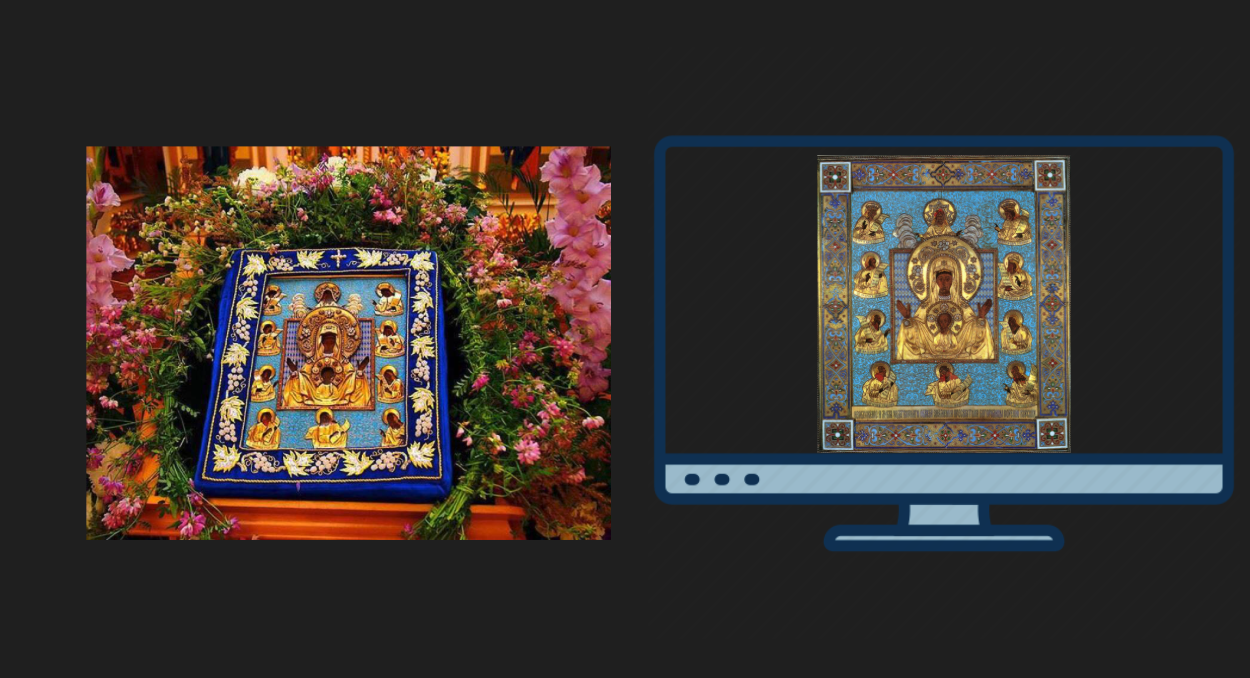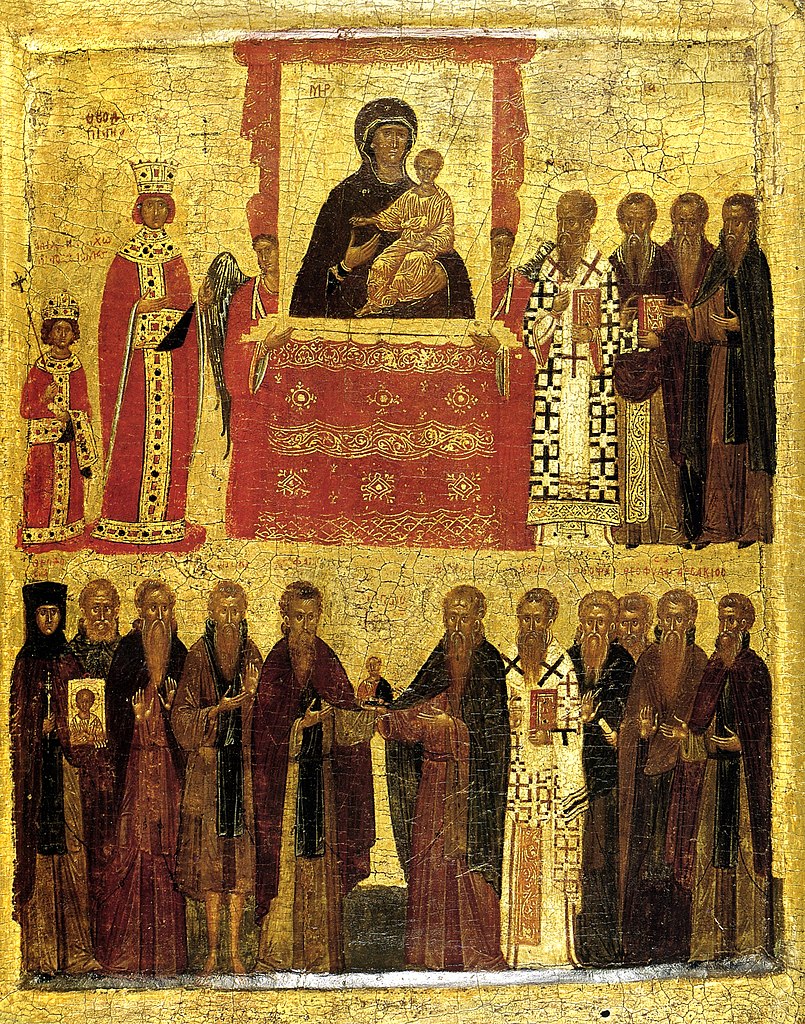The Triumph of Orthodoxy in the Digital Age
What can Icons teach us about being Orthodox in an increasingly virtual world?
What is an Icon?
“An icon is a representation of the invisible Godhead through the visible.”
– St John of Damascus, On the Divine Images
Icons are a special type of Orthodox Christian liturgical art. They can depict scenes from the Bible, important events from Christian history, images of saints, or Christ Himself. They are windows into the spiritual realm. God’s light, His uncreated energies, shine through them and into our lives.
What is Iconoclasm?
With some risk of oversimplification, we can summarize Iconoclasm as an 8th and 9th century heresy in which it was believed that God should never be pictured and that icons are idols and should not be used in worship. Iconoclasts were icon destroyers. Iconoclast literally means icon, or image, breaker.
Iconoclasts argued that we must worship God only in spirit and truth. They accused iconophiles (icon-lovers) of worshiping the creation instead of the creator, the image instead of the reality.
The Digital Age
Increasingly, we connect through new media.
A medium is an intervening substance through which something else is transmitted or carried on.
Increasingly, we experience life virtually.
And this virtual experience always happens through a medium, which means we don’t experience the actual reality or essence, but only the image or representation of reality.
Virtual reality seems like a new, cutting edge technology. But virtual realities have been around for ages. Stories, fiction, TV shows, movies, even your imagination, all of these things are a sort of virtual experience. They are false realities we escape into where we do not engage with the actual essence of things, but their representations.
Big Questions
Imagine, you have a rare opportunity to see the wonderworking Kursk Root Icon of the Theotokos. It will be at a small, local Russian Orthodox church for one evening only.
You drive up as the sun sets and park your car on the street. You see pious Christians streaming through the door, the men in white shirts, the womens’ heads covered. You walk through the door into the small chapel. You smell incense and hear soft chanting. You are surrounded by wood and iconography on every wall. The room is somewhat dimly lit, candles everywhere. On the left, a line of people waiting to venerate the famous icon. Their right sides illuminated with the dull, fake glow of a giant flatscreen TV, placed off to the right, showing a large image of the Kursk Root Icon.

Perhaps a few people, after bending and kissing the real icon, meander over to look at the TV image.
As you wait in line. You wonder – what is the real difference between the two?
If an icon is a window into the spiritual realm, is this icon on a screen also such a window? Why is no one venerating the image on the screen? Would anyone do such a thing? Is God present in the virtual image of the icon, the same way He is in the Kursk Root Icon itself? Is the computer screen made somehow holier in the instant that the icon flashes upon it?
More Questions
How is God in a book, take for example Harry Potter?
How is God in a video game, like Call of Duty?
We know that God is everywhere present and fills all things (from the Prayer to the Holy Spirit). But where is everywhere? Does “everywhere” include a virtual world like a video game? And what do we mean by fills all things? Does God fill a book or a virtual representation of a thing?
What has the world come to that we have to ask such questions!
Another Thought Experiment
Imagine you are walking along at dusk, the crickets and frogs are just starting their evening song and an owl hoots in the distance. You crest a hill and are met by a beautiful scene. A lake, reflecting the myriad colors of the setting sun. The reeds rustle in the wind and stars start to peek out of the color as the sky darkens.
How would you respond to such a scene? What thoughts would enter your mind? Perhaps you are worried about mosquitos? Perhaps you thank God and you see His handiwork in the sunset. You are moved to worship and to glorify Him by the magnificence of His creation. Would you say that God is in that sunset?
Now, you are in your basement with headphones on, sitting in front of your giant HD TV. You have the latest generation video game system and are playing an open world game famous for its visuals. You push forward on the controller, moving your character up to the top of a nearby hill.
As your view emerges on the other side, you are met with a scene that fills you with awe and wonder. Crickets chirp, an owl hoots in the distance. You hear the grass rustling around you. The sun sets before you in wild brilliance over a quiet lake. You hear thunder and see a distant dark cloud on the horizon.
Sure, you can’t smell or feel the wind in a video game, but these experiences are at least somewhat close, right? The video game is still wildly beautiful and might move you to wonder and awe. Is God present in that virtual scene? Is He in that video game sunset?
What is this virtual sunset? It isn’t a real sunset, we know that. But how is it really different? We can’t touch, smell, or taste a real sunset. You can only see it, similarly to the virtual sunset. The virtual sunset is really only an image, but it is a dynamic one, and a very good representation of a real sunset.
Could the light, the glory, the beauty, and wonder of God shine through in a virtual sunset?
It seems like it could! At least in a way.
The Connection
The chief argument the Iconoclasts levied against the Iconophiles was that icons were being used as idols. We as Christians should worship God, not dead wood and paint. We should worship the living God in spirit and truth.
The main counterarguments levied by the Church Fathers in defense of Orthodoxy were:
- We do not and must not use icons as idols
- We worship what in icon represents, not the image itself
- We venerate the Saints and exclusively worship God
Effectively, the Iconoclasts were wrong in their assumptions about how icons were to be used. It was never about the wood and paint. If your focus was in fact only on the icon and not on the glory of God, then you were worshiping in the wrong.
It was in the use of the image, its function, that the distinction was made. We use icons today to remind us of God. They help us worship God. Icons are a medium (singular of media) through which the Kingdom of Heaven is seen, as through a window.
The Problem

In the 8th and 9th century, Orthodoxy was threatened when our worship was challenged.
Orthodoxy triumphed in 843 with the reassertion of right-worship, including icons.
I believe that Orthodoxy is again threatened.
We are worshiping in a new way
Not at church, but at home.
We don’t kneel or stand. We sit in front of screens.
We don’t bow our heads in prayer. We slump over our phones scrolling social media.
Our days aren’t structured by the royal hours of prayer. They are instead interrupted and governed by notifications for the most recent message or perhaps a discount at your favorite store.
We have been led astray! We are worshiping the image, the representation, the virtual worlds that we access through our phones, TVs, and computers.
And this image is far more enticing than ever before. It’s dynamic, ever-changing and ever-evolving to cater to our every desire.
2020 Lockdown
Maybe you would prefer not to, but remember back. March 2020. Government mandated lockdown.
We didn’t go to church. It was not easy. It caused divisions among us. Churches split.
We cried at our lack of Communion. And it tore us apart.
But we came back.
Back to church, back to the sacraments (which are physical, not mere representations or symbols).
We came back to God in the flesh in the Eucharist.
We came back together.
The Triumph of Orthodoxy in the Digital Age
Here is how we are to reassert our right-worship. Here is how we are to triumph.
Come back!
Return from your digital and virtual escapes!
In our virtual places, we worship the created, the images, the representations of this world and the mere profiles and shells of real people.
When we watch TV or movies, play video games, read novels, scroll social, or shop online, we are looking for something. We look for good feelings and entertainment. We want a sweet distraction and a serotonin hit.
But these feelings, what we get from our virtual worlds, is only a shade, a projection, a fleeting image of true goodness. It is fickle. Anyone who drinks this water will soon become thirsty again.
We are standing at Jacob’s well, parched by the hot day, drawing water over and over.
Beside us stands Christ, the source of living water. If we drink from Him, that water will become a fountain within us springing up into everlasting life (John 4:14).
When we try to escape, we are really trying to seek the Kingdom of Heaven, the good life, eternal bliss, a land of peace and happiness. But that Kingdom does not exist in a virtual world, in a book, or on your phone.
The Kingdom of Heaven is at hand!
You see that the law
and everything it ordained
and all our own worship
consist in the consecration
of what is made by hands,
leading us through matter
to the invisible God.
– St John of Damascus, On the Divine Images
What happens as we are led closer and closer to the invisible God?
We become that fountain of water springing up into everlasting life. We consecrate what is around us.
The Kingdom of Heaven flows forth through us into the world we inhabit.
We are to be the icons of this world!
—
Jump to another session:
Session 1: Towards an Orthodox Understanding of Technology
Session 2: Technology in Your Life and Home – Take Back Control
Session 3: Understanding Social Media – An Orthodox Perspective
Session 4: – Current – The Triumph of Orthodoxy in the Digital Age – Icons & Virtual Reality
Session 5: Orthodoxy, Technology, & Parenting – Ask Me Anything w/ Fr. Tim Sas
—
Note from the Author:
Hello! I’m Cooper Buss. A layman having (at the time of writing this) just completed my first year of a Master’s of Theology at the Antiochian House of Studies and a parishioner at St. Mary’s Greek Orthodox Church in Minneapolis.
Thinking about and studying technology from an Orthodox perspective is a passion of mine and the focus of my studies. I hope to create much more content of this type as time goes on. If you have any ideas, questions, or comments, please email me at cooper@duck.com ! I’d love to hear from you.
In the meantime – PLEASE share this content wherever you see fit and wherever you believe God could work some good through it.